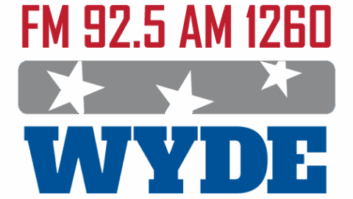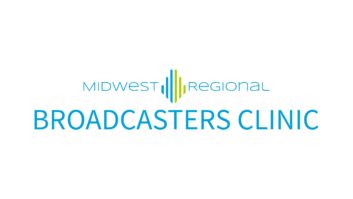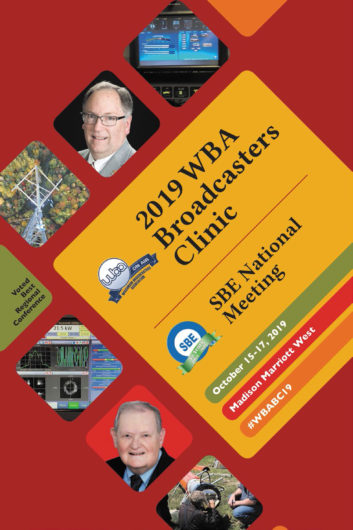
The 2019 Broadcasters Clinic will be held Oct. 15 to 17 at the Madison Marriott West Hotel in Middleton, Wis. The annual national meeting of the Society of Broadcast Engineers will be held in conjunction.
The “Madison clinic” is an industry tradition, kept vibrant even at a time when many regional events have disappeared. Its success has been thanks to an active leadership team, dedicated volunteers and ongoing association support.
Exhibitors and attendees have rewarded that investment by coming back year after year. Last year’s event won the award for Best Chapter Regional Educational Event from SBE.
This year’s clinic is dedicated to Gary Mach for 35 years of service to the Clinic Committee, from which he is retiring; organizers said his career has spanned nearly six decades “in every level of support from staff engineer to corporate engineer,” working for organizations including Wisconsin Public Broadcasting and PBS.
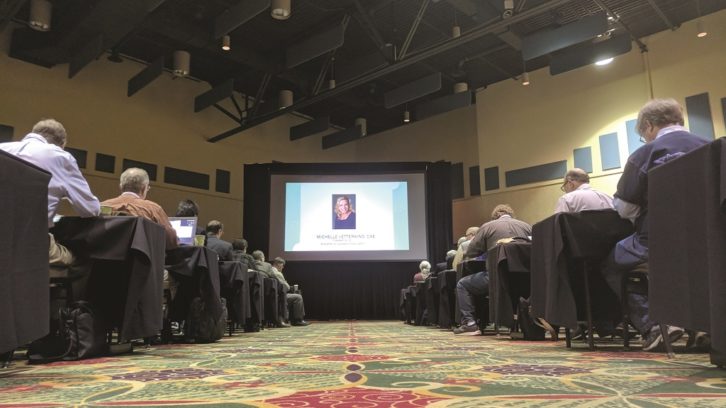
“The word ‘mentor’ only begins to demonstrate how he carried himself throughout his career,” WBA’s Leonard Charles said of Mach.
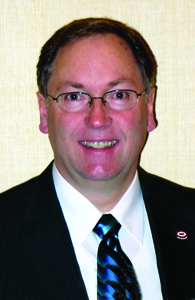
Also being saluted is WBA Clinic Committee member Bill Hubbard, recently retired from his own long engineering career. A charter member of Chapter 80, he recently was named the 2019 James C. Wulliman Educator of the Year by the SBE. Among other achievements, since 2013 he has contributed to the Media Technology Institute, a seminar to train new graduates in the basics of broadcast engineering. MTI was founded by Terry Baun who, in 2018, chose Hubbard to head the institute.
Below are sessions of interest to Radio World readers. See the full program, including TV-related presentations, at www.wi-broadcasters.org. For information about the SBE national meeting see sbe.org.
TUESDAY Oct. 15
8:30 a.m. — “War Stories: Tales from the Trenches”
Jeff Welton, Nautel
Show organizers remind us: “If you’ve seen any of Jeff’s presentations you will have noticed that he occasionally makes use of a ‘shouldn’t have done it that way’ photo — a picture taken demonstrating something that is done in a less-than-ideal manner.” He’ll share some of those and talk about what could be done to avoid such situations. “Names of stations shown will be withheld to protect the innocent.”
9:15 a.m. — “Possible Applications for Use of AM Broadcast Tower Space”
Tom F. King, President and CEO, Kintronic Labs Inc.
King will address solutions for using AM tower space for cellular telephone sites, broadband provider data services, LPTV antenna co-location for TV repack and other applications.
10:30 a.m. — “Faster, Cheaper, Better: Combining Today’s Lower-Cost Technology for Perfect Audio Now”
Kirk Harnack, Senior Solutions Consultant, The Telos Alliance
“While we’ve witnessed individual broadcast systems turn to networking for lower cost and better utilization, we’re now at the point where everything is connected with the same technology,” Harnack says. He highlights the latest implementations of networked audio and control. “We know something about VoIP and AoIP, but we’ll learn about MoIP and IoIP. Plus we’ll see how the IT industry keeps building upon existing and trusted protocols to bring reliability and cost-savings to broadcasters.”
11:15 a.m. — “Under the Hood, How AM HD Radio Works”
E. Glynn Walden, retired Senior VP of Engineering, CBS Radio
Walden, one of the fathers of IBOC, offers a brief discussion of how it came to be implemented as the U.S. digital radio platform over Eureka-147. He’ll then describe the Xperi AM HD Radio system including basics of OFDM and the elements needed to make AM HD radio work, including interleaving, error correction, reference carriers, the low-latency backup channel and instant tuning. He will also talk about performance in the presence of grounded conductive structures and the presence of interference.
1 p.m. — “Maximizing Your Content ROI with Podcasting”
Craig Bowman, Director R&D and Innovation, Futuri Media
Radio people know how to make great audio, so it follows that they should be able to make great podcasts, no? Well, not automatically. Bowman will discuss how radio can use podcasting and on-demand platforms to improve the ROI on content they are already creating while growing audience with original content.
1:45 p.m. — “Hybrid and Digital Radio: What Every Broadcaster Should Know”
David Layer, Vice President, Advanced Engineering, National Association of Broadcasters
“While the majority of radio listening still takes place on analog radios, broadcasters should be focusing on digital and hybrid (over-the-air plus internet) radio technologies as these represent radio’s future,” the organizers say. Layer will talk about radio technology work at the NAB dealing with digital and hybrid radio — “for the near term, making sure that broadcasters, manufacturers and service providers are all working together, and for the long term, helping to foster advances that will ensure radio’s prominence in autos for decades to come.”
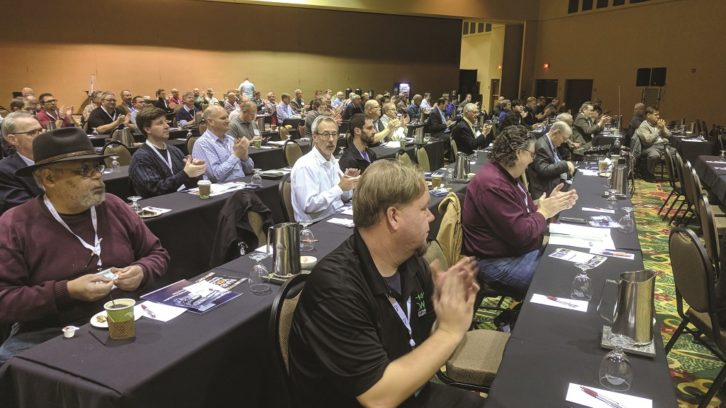
2:45 p.m. — “Troubleshooting Interactive Scenario/Heavy Duty Workbench”
Facilitators: John Bisset, Telos Alliance Radio Products Sales Manager for the Western U.S. and author of Radio World’s Workbench; Greg Dahl, Second Opinion Communications
An interactive presentation will troubleshoot common and uncommon problems at a broadcast facility. “Attendees will participate in small groups, learning and contributing during a condition of equipment failure and the scenario surrounding the failure.”
3:45 p.m. “Taking Your HD Signal to the Next Level Using Generation 4 Exporter and Importer Technology”
Kevin Haider, Product Line Manager, GatesAir
A walkthrough to better understand the differences between Generations 3 and 4 of HD Radio technology. Haider will address features such as the advantages of running a combined importer and exporter, and tools to help time alignment of the FM analog and digital audio.
7 p.m. — “Nuts and Bolts Session: Building the Perfect Pi”
Tim Wright, Cumulus Chicago
What’s cooler than solving a technical need by creating your own solution based on a Raspberry Pi microcomputer? Wright has developed various solutions at the Cumulus Chicago facility. Projects include Environmental monitoring, Axia Livewire routing control, making an older series XDS satellite receiver SNMP compatible, STL/TSL backups and a programmable studio clock/status display. Bring your laptop and your “wish list” projects for brainstorming.
WEDNESDAY Oct. 16
8 a.m. — “Broadcasting: What is Coming Next”
Steve Lampen, Consultant
What will the worlds of audio, video, broadcast and beyond look like in 10 years? In 20 years? “This presentation will depress some and excite others,” Lampen says. “I would love to hear your opinion on my predictions. Will we look back and laugh?”
8:45 a.m. — “Develop a COBO Plan for Your Station”
Manny Centeno, Project Manager, National Public Warning System (NPWS)
Centeno will provide a framework and best practices for developing a solid Continuity of Broadcast Operations Plan for your company or station to be prepared for major disasters.
1:30 p.m. — IT Security
Moderator Jeff Welton, Nautel
Panelists: Alex Hartman, Optimized Media Group; Chris Tarr, Entercom Milwaukee; and Wayne Pecena, Texas A&M University
This is a topic that unfortunately never goes out of fashion; indeed broadcast groups seem to be victimized by attacks ever more frequently.
3 p.m. — SBE Annual Membership Meeting
4 p.m. — Emergency Preparedness: From Tabletop to Action Plan
Tom Kujawa, recently retired Chief of Police for UW-Green Bay
Run a tabletop exercise at your facility to learn where the gaps are, identify solutions and refine your disaster planning in realistic ways. Chief Kujawa leads an interactive session that teaches you how to simulate a real-time, realistic event.
5–8 p.m. — SBE National Awards Reception & Awards Dinner
(requires separate registration)
THURSDAY Oct. 17

8:30 a.m. — “Real Time Monitoring of RF System Performance”
Dan Glavin, Dielectric Broadcast
“RF transmission systems are expensive and require annual maintenance to alleviate catastrophic failure, particularly for older systems,” Glavin says. “There are many monitoring systems that effectively measure VSWR and other performance issues in real time; however, fault location is not provided and requires additional resources.” He will discuss an IP-connected system providing broadcasters a way to monitor the RF system in real time, under full power with fault location.






